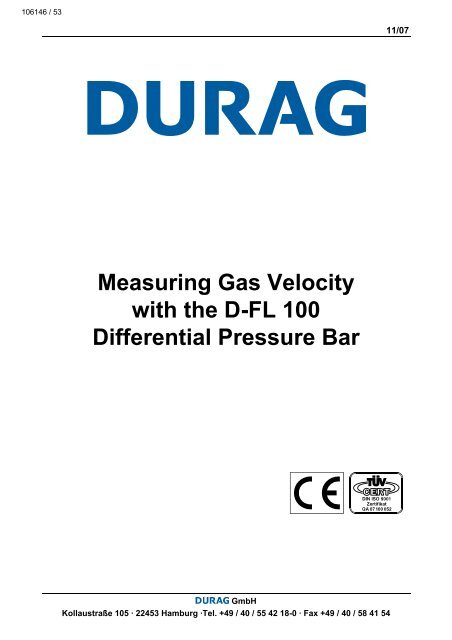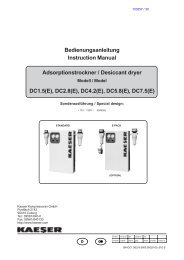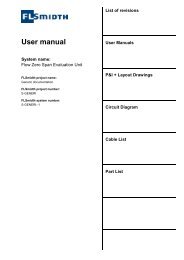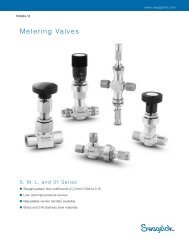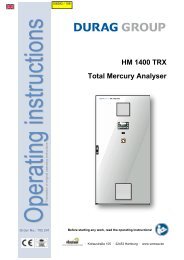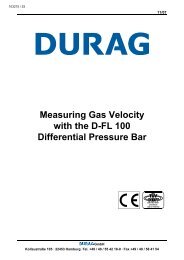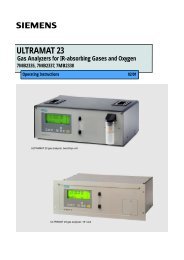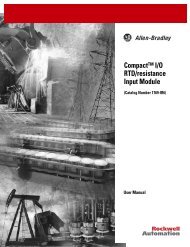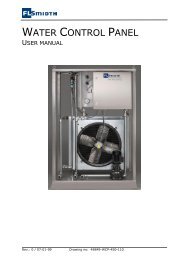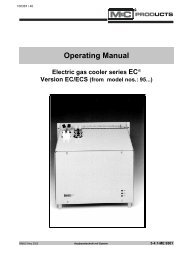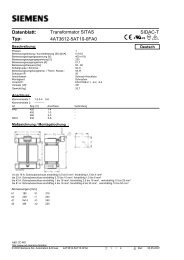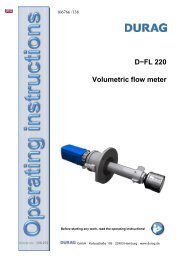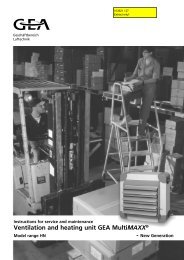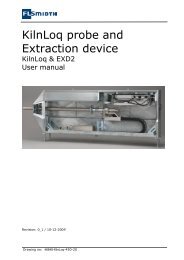Measuring Gas Velocity with the D-FL 100 Differential Pressure Bar
Measuring Gas Velocity with the D-FL 100 Differential Pressure Bar
Measuring Gas Velocity with the D-FL 100 Differential Pressure Bar
You also want an ePaper? Increase the reach of your titles
YUMPU automatically turns print PDFs into web optimized ePapers that Google loves.
11/07<strong>Measuring</strong> <strong>Gas</strong> <strong>Velocity</strong><strong>with</strong> <strong>the</strong> D-<strong>FL</strong> <strong>100</strong><strong>Differential</strong> <strong>Pressure</strong> <strong>Bar</strong>GmbHKollaustraße 105 · 22453 Hamburg ·Tel. +49 / 40 / 55 42 18-0 · Fax +49 / 40 / 58 41 54
Document:man_dfl<strong>100</strong>_uk.docVersion: 20.10.2007Last update: 07.12.2007Print date: 07.12.2007This documentationis valid from:Software-VersionD−<strong>FL</strong> 1.6 upwardsDURAG GmbHKollaustraße 10522453 HamburgTelephone: +49 (40) 55 42 18 – 0Fax : +49 (40) 58 41 54Email: info@durag.deInternet: www.durag.deThis documentation (approx. 53 pages) has been compiled <strong>with</strong> <strong>the</strong> greatest care. However, all liabilitymust be excluded.The contents of this document can be changed <strong>with</strong>out notice.The documentation of DURAG GmbH refers toa.) <strong>the</strong> complete equipment in principle, even if individual program modules or parts have not beenpurchasedb.) <strong>the</strong> current status of <strong>the</strong> equipment design at <strong>the</strong> time of updating this documentation (seeabove).© DURAG GmbH 2007Editorial department: Herbert Lange. All rights reserved.This document or parts of it may not be duplicated or communicated <strong>with</strong>out <strong>the</strong> express consent ofDURAG GmbH, irrespective of by which method or means, electronic or mechanical, this occurs.GmbH
D-<strong>FL</strong> <strong>100</strong>Table of Contents1. Application ...........................................................................................................................12. Functional Description........................................................................................................13. System Components of <strong>the</strong> D-<strong>FL</strong> <strong>100</strong>................................................................................63.1. <strong>Differential</strong> <strong>Pressure</strong> <strong>Bar</strong>...........................................................................................................73.2. <strong>Differential</strong> <strong>Pressure</strong> Transducer..............................................................................................83.3. D-<strong>FL</strong> <strong>100</strong>-10 Display.................................................................................................................94. Installation ..........................................................................................................................114.1. Choosing <strong>the</strong> <strong>Measuring</strong> Point................................................................................................114.2. Installing <strong>the</strong> <strong>Differential</strong> <strong>Pressure</strong> <strong>Bar</strong> ...................................................................................114.3. Electrical Connections ............................................................................................................144.4. Purge Air Connection ................................................................................................................195. Start-Up / Error Messages.................................................................................................205.1. Start-up of <strong>the</strong> Transducer......................................................................................................205.2. Start-up of <strong>the</strong> D-<strong>FL</strong> <strong>100</strong>-10 Display.......................................................................................215.2. Error Messages on <strong>the</strong> D-<strong>FL</strong> <strong>100</strong>-10 Display .........................................................................236. Recording of Measured Data............................................................................................237. Maintenance .......................................................................................................................248. Specifications of <strong>the</strong> D-<strong>FL</strong> <strong>100</strong> .........................................................................................259. Selecting <strong>the</strong> System Components..................................................................................299.1. Selecting <strong>the</strong> differential pressure transmitter ........................................................................299.2. Selecting a differential pressure bar .......................................................................................309.3. Selecting <strong>the</strong> differential pressure bar material ......................................................................319.4. Selecting <strong>the</strong> Type of Installation............................................................................................319.5. Ordering Information / Technical Overview ............................................................................329.6. Darstellung der Gerätevarianten.............................................................................................3510. Calculation sheet D-<strong>FL</strong> <strong>100</strong>...............................................................................................3810.1. Explanation of <strong>the</strong> calculation sheet D-<strong>FL</strong> <strong>100</strong> .......................................................................4011. <strong>Measuring</strong> Point Questionnaire........................................................................................43DURAG GROUP company addresses ................................................................................................48GmbH
D-<strong>FL</strong> <strong>100</strong>IllustrationsFig. 1: Diagram of a Pitot tube .......................................................................................................2Fig. 2: Diagram of a differential pressure bar inside a stack......................................................3Fig. 3: Dividing <strong>the</strong> duct/stack cross section into equal ring surfaces .....................................4Fig. 4: Possible settings of <strong>the</strong> switching valve...........................................................................5Fig. 5: Overview of <strong>the</strong> system components ................................................................................6Fig. 6: Cross section of <strong>the</strong> differential pressure bar..................................................................7Fig. 7: Diagram of a differential pressure transducer..................................................................8Fig. 8: Front cover of D-<strong>FL</strong> <strong>100</strong>-10 Display .................................................................................10Fig. 9: Installation positions of <strong>the</strong> differential pressure bar ...................................................12Fig. 10: Installation of <strong>the</strong> differential pressure bar I (Dimensions in mm)...............................12Fig. 11: Installation of <strong>the</strong> differential pressure bar II (Dimensions in mm)..............................13Fig. 12: Connection of <strong>the</strong> pressure pipes ...................................................................................13Fig. 13: Electrical connection of <strong>the</strong> transducer ..........................................................................14Fig. 14: Connection diagram of socket rack 1 (19-inch rack mount system) ...........................15Fig. 15: Connection diagram of socket rack 2 (19-inch rack mount system) ...........................16Fig. 16: Dimensions of D-<strong>FL</strong> <strong>100</strong>-10 (19-inch rack mount system) ............................................17Fig. 17: Connection diagram of terminal strip (housing model) ................................................18Fig. 18: Dimensions of D-<strong>FL</strong> <strong>100</strong>-G (fieldhousing for 19-inch rack)...........................................19Fig. 19: Turning knob ......................................................................................................................21Fig. 20: Probe cross sections ........................................................................................................27Fig. 21: Drawings of <strong>the</strong> mounting flanges...................................................................................28Fig. 22: Overview of parts...............................................................................................................32Abb. 23: Gerätevarianten, Darstellung außerhalb Kamin .............................................................35Abb. 24: Gerätevarianten, Darstellung im Kamin ..........................................................................36Abb. 25: Anschlussplatte, für Differenzdruck-Messumformer.....................................................37GmbH
D−<strong>FL</strong> <strong>100</strong> Seite 11. ApplicationOne of <strong>the</strong> most popular and reliable methods of measuring <strong>the</strong> differential pressure in a duct or stack isby means of a mechanical device such as a venturi or a differential pressure bar.The differential pressure bar is useful in measuring <strong>the</strong> velocity of exhaust gases that are not saturated<strong>with</strong> steam or water vapors. These gases may be generated by burning fossil fuels; e.g., in currentplants, waste incinerators and cement kilns. The differential pressure bar is designed to measurebetween 0 and 2,000,000 m 3 /h, depending on velocity and on <strong>the</strong> inner diameter of <strong>the</strong> duct/stack. Theminumum velocity should be more than 3 m/s.The DURAG D-<strong>FL</strong> <strong>100</strong> <strong>Velocity</strong> <strong>Measuring</strong> System has been suitability tested by TÜV Nord, Test ReportNo 128CU11650 dated 29. March 1996.2. Functional DescriptionThere are several advantages to using a differential pressure bar instead of a venturi to measure <strong>the</strong>velocity of a gas. A venturi reduces <strong>the</strong> pressure, thus causing pressure loss, whereas a differentialpressure bar has only a marginal influence on <strong>the</strong> gas flow. Because a differential pressure bar hasminimal effect on <strong>the</strong> gas flow, it can be used in shorter ducts/stacks, where installation of a venturiwould not be as cost-effective. Finally, a differential pressure bar requires less blower force for equalgas velocity, making it less expensive in overall operating costs.The velocity of a gas in a duct/stack is derived from <strong>the</strong> difference between <strong>the</strong> total impact pressureand <strong>the</strong> reference pressure on <strong>the</strong> differential pressure bar or Pitot tube (Fig. 1). This relationship isexpressed by Bernoulli’s equation:(Eq. 1)ΔPPgesPstatρvdifferential pressuretotal impact pressure (flow side)static (reference) pressuregas densityvelocityGmbH
D−<strong>FL</strong> <strong>100</strong> Seite 2Fig. 1:Diagram of a Pitot tubeIn a Pitot tube, <strong>the</strong> total reference pressure P ges is measured at <strong>the</strong> tip of <strong>the</strong> differential pressure bar,and <strong>the</strong> static pressure P stat is measured via lateral openings. However, <strong>the</strong> influence of <strong>the</strong> velocitysquared (v 2 ) component makes obtaining an accurate measurement difficult in <strong>the</strong> case of gases <strong>with</strong>very slight differential pressures and slight pressure variations.The differential pressure is <strong>the</strong>refore increased by using a reference pressure that is lower than <strong>the</strong>static pressure. A low-pressure area created through a vortex effect behind an object in <strong>the</strong> path of <strong>the</strong>flow can be used as a reference. The correction of <strong>the</strong> dynamic pressure according to Bernoulli (Eq. 2)is achieved <strong>with</strong> a so-called k -factor. The ma<strong>the</strong>matical relation between <strong>the</strong> differential pressure and<strong>the</strong> gas velocity is <strong>the</strong>refore as follows:(Eq. 2)VAkmass flowduct/stack cross-sectioncorrection factorWhen correcting volume or mass flow for temperature and absolute pressure, <strong>the</strong> density of <strong>the</strong>measured medium is taken into account. Equation 3 shows how <strong>the</strong> density depends on <strong>the</strong> twoparameters of an ideal gas:(Eq.3)ρ n normal density under standard conditionsP n standard pressure = 1,013 * 10 5 PaP operating pressure in PaT n standard temperature = 0 ° CT operating temperature in °CGmbH
D−<strong>FL</strong> <strong>100</strong> Seite 3The output signal at <strong>the</strong> D-<strong>FL</strong> <strong>100</strong>-10 Display can be corrected so that <strong>the</strong> current value of <strong>the</strong> volume ormass flow is displayed. To do this, <strong>the</strong> signals (4 - 20 mA) for absolute pressure and temperature mustbe accessible to <strong>the</strong> D-<strong>FL</strong> <strong>100</strong>-10 Display.The equation between <strong>the</strong> standard volume flow and <strong>the</strong> flow is:(Eq. 4)Taking <strong>the</strong> eqauations 2, 3 and 4 into account, <strong>the</strong> standard volum flow can be obtained by <strong>the</strong> followingequation:(Eq. 5)Fig. 2 shows a diagram of a differential pressure bar spanning <strong>the</strong> entire diameter of a stack. The twochamberdifferential pressure bar senses <strong>the</strong> impact and static pressures, and transfers <strong>the</strong>m separatelyto <strong>the</strong> differential pressure transmitter.Fig. 2:Diagram of a differential pressure bar inside a stackAs <strong>the</strong> gas velocity is not evenly distributed in a duct/stack, an average speed is derived to calculate gaspressure. With completely laminar flow patterns, a single differential pressure measurement wouldsuffice to calculate average gas velocity. This, however, requires very long input and output paths,which are usually not present.The average velocity is measured by means of <strong>the</strong> differential pressure bar placed across <strong>the</strong> entirediameter of <strong>the</strong> duct/stack. The duct/stack is divided into rings of equal areas, and measuring points areGmbH
D−<strong>FL</strong> <strong>100</strong> Seite 4placed on <strong>the</strong> differential pressure bar at different distances from <strong>the</strong> center of <strong>the</strong> duct/stack.Measurements are taken at all points simultaneously, and <strong>the</strong>refore <strong>the</strong> differential pressure is averagedright at <strong>the</strong> measuring points. The distance between <strong>the</strong> measuring points is calculated as follows:(Eq. 6)DabD Kindistance from <strong>the</strong> measuring point to <strong>the</strong>duct/stack wallduct/stack diameteri-fraction of partial surfacenumber of partial surfacesThe number of ring zones created is dependent on <strong>the</strong> diameter of <strong>the</strong> duct/stack. Five ring zones <strong>with</strong>ten measuring points are usually sufficient. (Please consult VDI guidelines DIN 2066, sheet 1 or yourappropriate regulatory agency.)Fig. 3:Dividing <strong>the</strong> duct/stack cross section into equal ring surfacesGmbH
D−<strong>FL</strong> <strong>100</strong> Seite 5To prevent residue accumulation on <strong>the</strong> differential pressure bar, <strong>the</strong> gas should be clean. Ductscontaining high-particulate gases should be periodically purged <strong>with</strong> compressed air. By moving <strong>the</strong>lever in front of <strong>the</strong> differential pressure bar, each chamber can be purged separately (Fig. 4).Fig. 4:Possible settings of <strong>the</strong> switching valveCalculating <strong>the</strong> volume of gas flow also depends on <strong>the</strong> density of <strong>the</strong> gas (Eq. 1). To obtain an accuratecalculation, <strong>the</strong> contents of <strong>the</strong> gas and <strong>the</strong>ir molecular weights must be known (DIN 1952). No gaswatermixtures can be measured, because of condensates.Because it is directly affected by gas density fluctuations, velocity must be measured under operatingconditions. If a calculation for standard conditions is required, <strong>the</strong> D-<strong>FL</strong> <strong>100</strong>-10 Display will take <strong>the</strong>static pressure and temperature into account. The gas density always depends more on temperaturethan on pressure, so <strong>the</strong> correction for absolute pressure can be neglected in most cases. Temperatureand pressure can be measured using additional sensors, and <strong>the</strong> results transferred to <strong>the</strong> D-<strong>FL</strong> <strong>100</strong>-10Display.GmbH
D−<strong>FL</strong> <strong>100</strong> Seite 63. System Components of <strong>the</strong> D-<strong>FL</strong> <strong>100</strong>The D-<strong>FL</strong> <strong>100</strong> measuring system consists of <strong>the</strong> following components:• differential pressure bar• differential pressure measuring transducer• D-<strong>FL</strong> <strong>100</strong>-10 DisplayFig. 5:Overview of <strong>the</strong> system componentsGmbH
D−<strong>FL</strong> <strong>100</strong> Seite 73.1. <strong>Differential</strong> <strong>Pressure</strong> <strong>Bar</strong>The special shape of <strong>the</strong> differential pressure bar provides a defined separation point for <strong>the</strong> gas flowaround its edges. This effects constant conditions for measurement in a large speed range.The separation point of <strong>the</strong> gas flow normally depends on <strong>the</strong> shape of <strong>the</strong> differential pressure bar’sedges and on <strong>the</strong> speed of <strong>the</strong> gas. If <strong>the</strong> position of <strong>the</strong> separation point of <strong>the</strong> gas flow on <strong>the</strong>differential pressure bar’s edges changes, a whirl will be created behind <strong>the</strong> differential pressure bar.The area behind <strong>the</strong> differential pressure bar thus has different pressure areas due to <strong>the</strong> differentwhirls. However, a constant flow pattern across <strong>the</strong> entire speed range on <strong>the</strong> back of <strong>the</strong> differentialpressure bar is required for a constant reference pressure. This is ensured by <strong>the</strong> following profile (Fig.6).Fig. 6:Cross section of <strong>the</strong> differential pressure barThe differential pressure bar has <strong>the</strong> shape of a tilted square divided into two chambers by an integrateddivider plate. The tips of <strong>the</strong> integrated divider plate create <strong>the</strong> differential pressure bar’s edges. Thedouble chamber system transfers <strong>the</strong> two pressures (impact pressure and reference pressure) outsideto <strong>the</strong> differential pressure transducer.The correction factor (c-factor) of <strong>the</strong> differential pressure bar (see Eq. 2) must be calculated taking intoaccount <strong>the</strong> geometry of <strong>the</strong> differential pressure bar and <strong>the</strong> dimensional relation of <strong>the</strong> differentialpressure bar to <strong>the</strong> duct/stack cross section. The c-factor is between 0.5 and 0.7, depending on <strong>the</strong>diameter of <strong>the</strong> duct/stack.The application of <strong>the</strong> differential pressure bar and <strong>the</strong> gas to be measured will determine what itscomposition should be. The standard differential pressure bar is made of stainless steel (material No.1.4571). O<strong>the</strong>r materials, such as stainless steel alloys, are available for extreme conditions (stainlesssteel alloy material No. 1.4539, Hastelloy C 276 material No. 2.4819, Inconel 602 material o. 2.4816).GmbH
D−<strong>FL</strong> <strong>100</strong> Seite 83.2. <strong>Differential</strong> <strong>Pressure</strong> TransducerThe differential pressure is measured using <strong>the</strong> differential pressure transducer. Fig. 7 is a diagram of atransducer.The differential pressure is transmitted, via separating membranes and a filling liquid, to a siliciumpressure sensor. If <strong>the</strong> measuring limits are exceeded, <strong>the</strong> overload membrane expands until one of <strong>the</strong>separating membranes attaches itself to <strong>the</strong> pressure sensor and <strong>the</strong>reby protects <strong>the</strong> silicon sensorfrom overloads.The applied differential pressure expands <strong>the</strong> measuring membrane laterally. Consequently, <strong>the</strong> piezoresistors, which are switched in a jumper array and integrated into <strong>the</strong> measuring membrane, change<strong>the</strong>ir respective resistive load value. This change in resistor load leads to a jumper output voltage whichis proportional to <strong>the</strong> differential pressure. This signal is transformed into an output current of 4 to 20mA.Fig. 7:Diagram of a differential pressure transducerThe range of <strong>the</strong> differential pressure transducer can be adjusted to anywhere from 1 to 20 mbar. Theseparating membranes inside <strong>the</strong> transducer can be made of ei<strong>the</strong>r stainless steel (material No. 1.4404)or Hastelloy C276 (material No. 2.4819).The differential pressure transducer comes <strong>with</strong> an installation bracket and a switching valve mounteddirectly on <strong>the</strong> transducer. The switching valve permits cleaning of <strong>the</strong> differential pressure bar <strong>with</strong>compressed air, <strong>the</strong>reby leng<strong>the</strong>ning its maintenance cycle. The zero point check of <strong>the</strong> differentialpressure transducer can also be performed <strong>with</strong> <strong>the</strong> switching valve.The transducer must always be installed above <strong>the</strong> differential pressure bar. At least <strong>the</strong> first part of <strong>the</strong>supply line from <strong>the</strong> differential pressure bar should be installed at a slight incline toward <strong>the</strong> differentialpressure transducer, so that condensation can flow back to <strong>the</strong> bar in this area.When <strong>the</strong> ambient temperature is lower than <strong>the</strong> gas temperature, condensation buildup -- especiallyinside <strong>the</strong> supply lines to <strong>the</strong> differential pressure transducer -- will alter <strong>the</strong> measurement considerably.GmbH
D−<strong>FL</strong> <strong>100</strong> Seite 9If <strong>the</strong> differential pressure transducer cannot be installed higher than <strong>the</strong> measuring differential pressurebar, at least <strong>the</strong> first part of <strong>the</strong> supply line should angle upward to <strong>the</strong> differential pressure transducer,so that <strong>the</strong> condensation can flow back to <strong>the</strong> differential pressure bar in this area.The auxiliary current of <strong>the</strong> differential pressure transducer is 11 to 30 VDC and is supplied by <strong>the</strong> D-<strong>FL</strong><strong>100</strong>-10 Display (24 VDC). Please consult <strong>the</strong> operating manual for fur<strong>the</strong>r details.3.3. D-<strong>FL</strong> <strong>100</strong>-10 DisplayThe D-<strong>FL</strong> <strong>100</strong>-10 Display evaluates <strong>the</strong> measuring signal from <strong>the</strong> differential pressure transducer underdifferent application conditions. <strong>Gas</strong> velocity is usually evaluated under operating conditions. If acomparison of <strong>the</strong> volume or mass flow to standard values is desired, fur<strong>the</strong>r gas flow parameters mustbe provided to <strong>the</strong> D-<strong>FL</strong> <strong>100</strong>-10 Display. Connections for temperature and pressure sensors areavailable for this purpose.A current signal of 4 to 20 mA is available as an output proportional to <strong>the</strong> volume or mass flow. It canbe connected to additional evaluation devices, such as <strong>the</strong> emissions D-<strong>FL</strong> <strong>100</strong>-10 Display, recorder ora DAS. The current measured value is shown on a display. Parameters such as inner stack diameter,standard density, c-factor and measuring ranges are programmed on site.The D-<strong>FL</strong> <strong>100</strong>-10 Display consists of a 19-inch rack mount (width 21 TE; height 3 HE) <strong>with</strong> its owndisplay. If no cabinet is available, <strong>the</strong> unit can be delivered <strong>with</strong> a plastic wall housing (24 TE).There are two signals to indicate that <strong>the</strong> set limit values have been exceeded, and an additional signalfor <strong>the</strong> status “maintenance/measuring.”Four keys are used to operate <strong>the</strong> evaluator: MOD, STO, , . The MOD key leads to <strong>the</strong> setting modeand illuminates <strong>the</strong> upper yellow indicator light. By pressing <strong>the</strong> key, <strong>the</strong> desired function (shown in<strong>the</strong> following chart) is selected and <strong>the</strong> respective LED will be illuminated. The stored values of <strong>the</strong>corresponding function are shown on <strong>the</strong> display. If <strong>the</strong> value does not need to be changed, press <strong>the</strong>MOD key once more to exit <strong>the</strong> setting mode. To change <strong>the</strong> value, press <strong>the</strong> STO key. The four-digitdisplay will show a blinking digit.This digit can be increased by pressing <strong>the</strong> key. Choose <strong>the</strong> next digit by pressing <strong>the</strong> key.Pressing <strong>the</strong> STO key transfers <strong>the</strong> changed value into non-volatile memory (EEPROM). The LEDinside <strong>the</strong> STO key will switch off, and <strong>the</strong> saved value will be displayed. The system automaticallydetermines whe<strong>the</strong>r a programmed value is larger than 20 mA. If <strong>the</strong> value is larger than 20 mA, it willnot be saved; <strong>the</strong> previous value will once again be displayed. The setting mode can be left by pressing<strong>the</strong> MOD key. The LED inside <strong>the</strong> MOD key switches off.Fig. 8 shows <strong>the</strong> front cover of <strong>the</strong> D-<strong>FL</strong> <strong>100</strong>-10 Display.GmbH
D−<strong>FL</strong> <strong>100</strong> Seite 10LED DisplayStand byIntgL.V.1L.V.2DisplayFunctionunit is in service, zero point testing of differentialpressure transducerintegration time in seconds1st limit value, smaller than L.V.2 in mA (from <strong>the</strong>output current signal)2nd limit value, larger than L.V.1 in mA (from <strong>the</strong>output current signal)shown on display:• volume flow <strong>100</strong>0 m3/h• mass flow <strong>100</strong>0 kg/h• current output 4-20 mADPHP differential pressure in hPa (mbar)P HP absolut pressure in hPa (mbar), only <strong>the</strong>three least significant numbers are displayed,e.g. 1013 hPa is displayed like P013t °C temperature in °CFig. 8:Front cover of D-<strong>FL</strong> <strong>100</strong>-10 DisplayGmbH
D−<strong>FL</strong> <strong>100</strong> Seite 114. Installation4.1. Choosing <strong>the</strong> <strong>Measuring</strong> PointThe technical configurations of boilers and smokestacks vary widely. It is advisable to have <strong>the</strong>measuring point determined by <strong>the</strong> local regulatory agency, which later also calibrates <strong>the</strong> emissionmonitoring facility.The measuring point for <strong>the</strong> D-<strong>FL</strong> <strong>100</strong> inside <strong>the</strong> duct/stack must have a fairly constant velocitydistribution and should never drop below <strong>the</strong> dewpoint of <strong>the</strong> gases.The measuring point should not be located close to a bend or a change of diameter in <strong>the</strong> duct. Theinput path (distance before <strong>the</strong> measuring point) and <strong>the</strong> output path (distance behind <strong>the</strong> measuringpoint) should be at least 3D (D=inner diameter of duct/stack). If <strong>the</strong>re is not enough space, <strong>the</strong> inputpath must be longer than <strong>the</strong> output path. D represents <strong>the</strong> diameter of a round stack or <strong>the</strong> hydraulicdiameter of a square or rectangular cross section (Eq. 7).F = areaU = circumference(Eq. 7)If <strong>the</strong> measuring point lies between a filter and a suction fan, <strong>the</strong> installation point should be directedtoward <strong>the</strong> suction fan ra<strong>the</strong>r than <strong>the</strong> filter. Vibrations at <strong>the</strong> mounting point -- often caused by <strong>the</strong>suction fan -- cannot always be avoided. But if, at full load, <strong>the</strong> vibrations become so strong thatmechanical parts or electrical settings are jeopardized, <strong>the</strong> installation should be made separate from<strong>the</strong> vibrating suction fan.The measuring point must be safely accessible not only during start-up or calibration, but also for latermaintenance and service.4.2. Installing <strong>the</strong> <strong>Differential</strong> <strong>Pressure</strong> <strong>Bar</strong>First attach <strong>the</strong> installation flange to <strong>the</strong> duct/stack, <strong>the</strong>n attach <strong>the</strong> differential pressure bar to <strong>the</strong>flange. Please observe <strong>the</strong> following installation guidelines:• Always install <strong>the</strong> differential pressure bar horizontally <strong>with</strong> a slight decline so that condensatescannot flow from <strong>the</strong> differential pressure bar to <strong>the</strong> pressure transducer (Fig. 9).• Provide sufficient space above <strong>the</strong> differential pressure bar for <strong>the</strong> differential pressure transducerand <strong>the</strong> switching valve. If <strong>the</strong> differential pressure transducer will not be installed above <strong>the</strong>differential pressure bar, make sure <strong>the</strong> pipes to <strong>the</strong> transducer are inclined.• Attach <strong>the</strong> differential pressure bar to <strong>the</strong> flange in <strong>the</strong> direction of <strong>the</strong> flow or toward <strong>the</strong> duct/stack,so that <strong>the</strong> openings at one of <strong>the</strong> chambers of <strong>the</strong> differential pressure bar are pointing toward <strong>the</strong>gas flow. The openings at <strong>the</strong> o<strong>the</strong>r chamber are now located on <strong>the</strong> side turned away from <strong>the</strong> flow.Only in this position can a correct differential pressure reading be assured.• Make sure <strong>the</strong> pressure pipes of <strong>the</strong> differential pressure bar are connected to <strong>the</strong> correct side of<strong>the</strong> differential pressure transducer. The flow-side chamber of <strong>the</strong> differential pressure bar must beconnected to <strong>the</strong> positive input of <strong>the</strong> differential pressure transducer, <strong>the</strong> o<strong>the</strong>r chamber <strong>with</strong> <strong>the</strong>negative input. (see also Fig. 12.)GmbH
D−<strong>FL</strong> <strong>100</strong> Seite 12After <strong>the</strong> differential pressure bar and <strong>the</strong> differential pressure transducer have been properly connectedto <strong>the</strong> electrical system and to each o<strong>the</strong>r, <strong>the</strong> differential pressure bar can be operated.Fig. 9:Installation positions of <strong>the</strong> differential pressure barFig. 10:Installation of <strong>the</strong> differential pressure bar I (Dimensions in mm)GmbH
D−<strong>FL</strong> <strong>100</strong> Seite 13Fig. 11:Installation of <strong>the</strong> differential pressure bar II (Dimensions in mm)untere SondenkammerLower probe chamberuntere SondenkammerLower probe chamberAdapter fürUmschalthahnAdapter forcross overcockAdapter fürSchlauchanschlussAdapter forhose connectionobere SondenkammerUpper probe chamberobere SondenkammerUpper probe chamberFig. 12:Connection of <strong>the</strong> pressure pipesGmbH
D−<strong>FL</strong> <strong>100</strong> Seite 144.3. Electrical ConnectionsIf a 19-inch cabinet is available, <strong>the</strong> D-<strong>FL</strong> <strong>100</strong>-10 Display can be ordered as a rack mount system.Electricity is connected via two socket racks at <strong>the</strong> rear of <strong>the</strong> unit as shown in Figs. 14 and 15.If <strong>the</strong> D-<strong>FL</strong> <strong>100</strong>-10 Display cannot be installed in a cabinet, it can be ordered <strong>with</strong> its own housing. Inthis case, <strong>the</strong> electrical connection is made via a 20-pin terminal strip in <strong>the</strong> terminal part of <strong>the</strong> housingas shown in Fig. 17. The electrical connection between <strong>the</strong> differential pressure transducer and <strong>the</strong> D-<strong>FL</strong> <strong>100</strong>-10 Display is a cable attached to <strong>the</strong> transducer. The cables for main current, status signal,recorder output and alarm contact should be installed separately. The connection to <strong>the</strong> recorder shouldbe shielded.If <strong>the</strong> D-<strong>FL</strong> <strong>100</strong>-10 is not used, <strong>the</strong> transducer must be supplied directly <strong>with</strong> auxiliary current from a UH11...30 VDC unit. The connections are behind <strong>the</strong> housing cover. (Fig. 13). The output of <strong>the</strong> transduceris read from <strong>the</strong> load R. The maximum load is calculated as follows:(Eq. 8)U Haux. energy in VFig. 13:Electrical connection of <strong>the</strong> transducerCAUTION!With all installations involving D-<strong>FL</strong> <strong>100</strong>-10 differential pressure transducers andD-<strong>FL</strong> <strong>100</strong>-10 Displays, <strong>the</strong> currently applicable VDE guidelines and any supplementarystipulations of local energy-generating utilities must be observed.GmbH
D−<strong>FL</strong> <strong>100</strong> Seite 15Fig. 14:Connection diagram of socket rack 1 (19-inch rack mount system)GmbH
D−<strong>FL</strong> <strong>100</strong> Seite 16Fig. 15:Connection diagram of socket rack 2 (19-inch rack mount system)GmbH
D−<strong>FL</strong> <strong>100</strong> Seite 17Fig. 16:Dimensions of D-<strong>FL</strong> <strong>100</strong>-10 (19-inch rack mount system)GmbH
D−<strong>FL</strong> <strong>100</strong> Seite 18Fig. 17:Connection diagram of terminal strip (housing model)GmbH
D−<strong>FL</strong> <strong>100</strong> Seite 19250 mm13538,5 188,5[B]246230170[B][B]B = 3-Punkt-WandbefestigungsbohrungenØ 5mmG11-01-006120M20 x 1,5M16 x 1,567Fig. 18:Dimensions of D-<strong>FL</strong> <strong>100</strong>-G (fieldhousing for 19-inch rack)4.4. Purge Air ConnectionIn order to clean <strong>the</strong> differential pressure bar, or to keep it clean, it is recommended to havecompressed air inside <strong>the</strong> pressure chambers. The compressed air can be used to purge <strong>the</strong> pressurechambers of <strong>the</strong> differential pressure bar. The flow of purge air is controlled by <strong>the</strong> switching valve. If<strong>the</strong>re is no purge air (compressed air: 6-8 bar) at <strong>the</strong> measuring point, a simple compressed air bottlewill do. Backflow intervals are rarely very short. The frequency of <strong>the</strong> need for cleaning depends on <strong>the</strong>dust load in <strong>the</strong> exhaust stack and on <strong>the</strong> application. Generally, <strong>the</strong> differential pressure bar should becleaned at intervals of several weeks or months.If <strong>the</strong> chambers in <strong>the</strong> differential pressure bar are so clogged that purge air will not clean <strong>the</strong>m, remove<strong>the</strong> differential pressure bar and adapter piece and clean <strong>the</strong> interior of <strong>the</strong> bar mechanically.GmbH
D−<strong>FL</strong> <strong>100</strong> Seite 205. Start-Up / Error Messages5.1. Start-up of <strong>the</strong> TransducerThe differential pressure bar is equipped standard <strong>with</strong> a differential pressure transducer 2010TD madeby ABB <strong>with</strong>out a display.The transducer will be shipped adjusted (* by Durag. After mounting <strong>the</strong> transmitter it is only necessaryto do a zero point adjustment.1) turn <strong>the</strong> switching valve to <strong>the</strong> position zero point adjustment2) open exhaust screws and wait 30 sec.3) open <strong>the</strong> key-cover on <strong>the</strong> top of <strong>the</strong> transducer4) press down <strong>the</strong> lock-key „ / M“ <strong>with</strong> a screwdriver and turn it 90°5) press <strong>the</strong> „0% / -“ key once6) turn back <strong>the</strong> lock-key to lock <strong>the</strong> transducerNow <strong>the</strong> transducer is adjusted ans should be readout 4mA.If you want to change <strong>the</strong> measuring range <strong>the</strong>re are three possibilities:• 1) open <strong>the</strong> key-cover on <strong>the</strong> top of <strong>the</strong> transducer2) press down <strong>the</strong> lock-key „ / M“ <strong>with</strong> a screwdriver and turn it 90°3) connect a definied pressure for <strong>the</strong> beginning of <strong>the</strong> measuring range (normaly 0 mbar) andwait 30s for stabilisation4) press <strong>the</strong> „0% / -“ Key once5) connect pressure for <strong>the</strong> end of <strong>the</strong> measuring range and wait 30s for stabilisation6) press <strong>the</strong> „<strong>100</strong>% / +“ Key once7) turn back <strong>the</strong> lock-key to lock <strong>the</strong> transducer• It is possible to order a LC-display <strong>with</strong> two additional keys. With this display you can change veryparameter of <strong>the</strong> transducer.• The transducers have a HART-interface for programming <strong>the</strong> parametersNote: you have to change <strong>the</strong> parameter of your evaluation unit (D-<strong>FL</strong><strong>100</strong>-10) also.(* measuring range see chapter 9.1; damping 5s; transfer function: rootGmbH
D−<strong>FL</strong> <strong>100</strong> Seite 215.2. Start-up of <strong>the</strong> D-<strong>FL</strong> <strong>100</strong>-10 Display• After all electrical connections have been made, parameters to calculate volume or mass flow canbe set in <strong>the</strong> D-<strong>FL</strong> <strong>100</strong>-10 Display. This is done by setting <strong>the</strong> turning knob.Drehschalterturning knobFig. 19:Turning knobThe turning knob has <strong>the</strong> following settings:Turning knob settingOperating mode0 measuring mode1 installation mode 12 installation mode 23 installation mode 3In <strong>the</strong> installation modes <strong>the</strong> LED are used in combination <strong>with</strong> <strong>the</strong> following parameters:LED readout installation mode 1Stand by D Kinner diameter in mmIntg c c-factor (entering digits after <strong>the</strong> decimal point)L.V.2 ΔP upper value of measuring span of <strong>the</strong> differential pressuretransducer in Pa (1 mbar = <strong>100</strong> Pa)This value must correspond to <strong>the</strong> setting on <strong>the</strong>differential pressure transducer. The D-<strong>FL</strong> <strong>100</strong>-10 Displayrecalculates <strong>the</strong> numerical value of <strong>the</strong> differential pressurebased on this reference value and <strong>the</strong> current of <strong>the</strong>transducer (e.g., 20 mA = 2000 Pa).L.V.1 m3/h volumetric measuring range in <strong>100</strong>0 m 3 /hThis parameter is <strong>the</strong> reference value of <strong>the</strong> mA output. 20mA are emitted as soon as this gas flow value is reached.Display ρ gas density at standard operating conditions in kg/Nm³Error T operating temperature in °CGmbH
D−<strong>FL</strong> <strong>100</strong> Seite 22LED readout installation mode 2Stand by T_0 zeropoint, temperature transmitter in °CIntg T_span span, temperature transmitter in °CL.V.2 P_0 zero point, absolute pressure transmitter in barL.V.1 P_span span, absolute pressure transmitter in barDisplay t_purge cycle time, automatic backflow purging in h9999 backflow disabled0000 DR_release enabled, time release disabledelseError C_mod calculation modeDR_release and time release enabled0000 standard volume flow, temperature constant, absolutepressure constant0001 standard volume flow, calculation <strong>with</strong> temperature input,absolute pressure constant0002 standard volume flow, calculation <strong>with</strong> absolute pressureinput, temperature constant0003 standard volume flow, calculation <strong>with</strong> temperature andabsolute pressure inputLED readout installation mode 3Stand by I_out 20 mA output, adjustmentIntg Code codenumber, unlock input-adjustment, code 8888L.V.2 I_dp input differential pressure transmitter, adjustmentL.V.1 I_Tmp input temperature transmitter, adjustmentDisplay I_P input absolute pressure transmitter, adjustmentErrornot usedThe parametrisation is done in installation mode 1 and 2. The installation mode 3 is only used for <strong>the</strong>adjustment for <strong>the</strong> mA inputs and output (alredy done by <strong>the</strong> manufacturer).GmbH
D−<strong>FL</strong> <strong>100</strong> Seite 235.3. Error Messages on <strong>the</strong> D-<strong>FL</strong> <strong>100</strong>-10 DisplayThe D-<strong>FL</strong> <strong>100</strong>-10 Display puts out <strong>the</strong> following error messages on <strong>the</strong> display:Displayed error Cause of error SolutionE-01 The absolute pressure transmitterputs out a signal less than 3.8 mA.E-02 The temperature transmitter puts outa signal less than 3.8 mA.E-04 The differential pressure transmitterputs out a signal less than 3.8 mA.E-08 The current entering at <strong>the</strong> input of<strong>the</strong> differential pressure (absolutepressure or temperature) transmittermeasures more than 20 mA.Check connections and connectingwires. Calibrate transmitter ifnecessary.Check connections and connectingwires. Calibrate transmitter ifnecessary.Check connections and connectingwires. Calibrate transmitter ifnecessary.Check transmitter and calibrateanew if necessary.E-16 Defective RAM Restart unit and replace RAM-IC ifnecessary (DURAG service).E-32 Spill: <strong>the</strong> gas velocity is too high. Increase gas velocity measuringrange (see Section 5.2: Start-up,turn turning knob at setting 1, valueat L.V.1)E-64 EEPROM transmission error Restart unit and replace EEPROM ifnecessary (DURAG service).FEHLThe turning knob is switched to anillegal position ( > 3)Check <strong>the</strong> position of <strong>the</strong> turningknobThe displayed error number is <strong>the</strong> sum of all actual errors, e.g. E-05 means: E-01 and E-04.During <strong>the</strong>se error messages, a signal of 2 mA of current is read at <strong>the</strong> output of <strong>the</strong>D-<strong>FL</strong> <strong>100</strong>-10 Display.6. Recording of Measured DataThe D-<strong>FL</strong> <strong>100</strong>-10 Display puts out <strong>the</strong> present measured data as an analog electrical signal. Accordingto industry standards, <strong>the</strong>re should be a continuous recording of measured values. The following stripchart recorders are recommended: recorders of 0-20 mA <strong>with</strong> recording width of at least <strong>100</strong> mm. Thelive zero point of <strong>the</strong> display is at 20% (4 mA) of <strong>the</strong> recording scale.The measurements and status signals may, however, also be evaluated by an emission computerdownstream.GmbH
D−<strong>FL</strong> <strong>100</strong> Seite 247. MaintenanceThe D-<strong>FL</strong> <strong>100</strong> is a low-maintenance system <strong>with</strong> long maintenance intervals. The maintenance scheduledepends on <strong>the</strong> application, and is generally several months (3 months as a rule of thumb). <strong>Pressure</strong>conditions, climatic and o<strong>the</strong>r ambient influences at <strong>the</strong> measuring site, and <strong>the</strong> gas being measured allaffect <strong>the</strong> maintenance schedule.Maintenance work should be performed in <strong>the</strong> following order:1. Adjust menu item Maintenance at <strong>the</strong> D-<strong>FL</strong> <strong>100</strong>-10 Display.Use <strong>the</strong> MOD key on <strong>the</strong> D-<strong>FL</strong> <strong>100</strong>-10 Display to select Stand by.2. Clean <strong>the</strong> exterior of <strong>the</strong> unit.3. Check <strong>the</strong> differential pressure bar and <strong>the</strong> differential pressure transducer.Check exterior covers and <strong>the</strong> connections between differential pre ssure bar and transducer.4. Flush <strong>the</strong> measuring pipes.The pipes may need to be flushed, depending on application conditions. By changing <strong>the</strong> setting of<strong>the</strong> switching valve, purge air is directed separately to <strong>the</strong> different pressure lines (see Fig. 4 forswitching valve settings).5. Clean <strong>the</strong> differential pressure bar.Under extreme application conditions, when a simple flushing of <strong>the</strong> pressure lines would not besufficient, <strong>the</strong> differential pressure bar must be cleaned <strong>with</strong> a cloth or a brush. The differentialpressure bar must first be disconnected from <strong>the</strong> transducer and removed from <strong>the</strong> duct/stack. Themaintenance intervals need to be shorter under such extreme application conditions.6. Make a zero point adjustment of <strong>the</strong> differential pressure transducer.The two wires on <strong>the</strong> transducer are cross-wired via <strong>the</strong> switching valve, and <strong>the</strong> exhaust screwsare opened briefly and shut again (pressure equalization at transducer).Remove <strong>the</strong> housing cover from <strong>the</strong> transducer to monitor <strong>the</strong> electric current signal on <strong>the</strong> display.The current output must now be 4.00 mA. If it is not, a zero point adjustment must be made.Remove both screws from <strong>the</strong> protective cover and remove <strong>the</strong> cover. Use <strong>the</strong> M key to proceed topoint 7 and perform <strong>the</strong> adjustment. Press and simultaneously for about 2 seconds. Thedisplay should now show 4.00 mA; if it does not, repeat <strong>the</strong> adjustment.7. Switch on <strong>the</strong> D-<strong>FL</strong> <strong>100</strong>-10 Display.Use <strong>the</strong> MOD key on <strong>the</strong> D-<strong>FL</strong> <strong>100</strong>-10 Display to proceed <strong>with</strong> <strong>the</strong> measuring process.GmbH
D−<strong>FL</strong> <strong>100</strong> Seite 258. Specifications of <strong>the</strong> D-<strong>FL</strong> <strong>100</strong><strong>Measuring</strong> principle: Continuous in situ measurement by <strong>the</strong> differential pressure method.Lengths of <strong>the</strong> measuring paths:<strong>Differential</strong> pressure bar I: ...................................... 400 - 2000 mm (15 ¾ in. – 78 ¾ in.)<strong>Differential</strong> pressure bar II: ..................................... 2000 - 4000mm (78 ¾ in. – 157 ½ in.)<strong>Differential</strong> pressure bar lll: ..................................... 4000-8000mm (157 ½ in.) – 315 in.)<strong>Measuring</strong> range: ................................................... 0 - 2.000.000 Nm³/h,Minimum velocity: ................................................... 3 m/sExhaust temperature (standard material):............... min. greater than <strong>the</strong> dew point................................................................................. max. 400°C<strong>Differential</strong> pressure bar material: .......................... 1.4571 (standard),2.4819, 2.4816 according to customer requestMargin of error: ....................................................... +/-2%Electrical specifications of <strong>the</strong> D-<strong>FL</strong> <strong>100</strong>-10 DisplayVoltage: .................................................................. 115/230 V (±10%)Frequency: .............................................................. 50/60 Hz(O<strong>the</strong>r voltages and frequencies are available upon request.)Limiting valueTwo independently adjustable limiting values: L.V. 1, L.V. 21 x Status "Measure"All relay contacts potential-free,maximal load at cosϕ = 1: ...................................... 230V / 0.5AMaximum admissible ambient temperature range: -20° +50°CIntegration period of <strong>the</strong> measured value: .............. 1 - 180 sec (freely selectable)Output signal: ......................................................... analog 4 - 20 mAMaximum load: ....................................................... 500 OhmLive zero: ................................................................ 4 mAProtection/weight:rack mount model (IP20): ................................... 2,0 kghousing model (IP65): ....................................... 2,2 kgGmbH
D−<strong>FL</strong> <strong>100</strong> Seite 26<strong>Differential</strong> <strong>Pressure</strong> Transducer265DS (ABB)Adjustable measuring range: .................................. 1 to 10 mbarAuxiliary current: ..................................................... DC 12 - 30 VOutput signal: ......................................................... 4 - 20 mAProtection: ............................................................... IP65Absolute <strong>Pressure</strong> Transducer265AS (ABB)Adjustable measuring range: .................................. 900 to 1300 mbarAuxiliary current: ..................................................... DC 12 - 45 VOutput signal: ......................................................... 4 - 20 mAProtection: ............................................................... IP65Temperature <strong>Measuring</strong> UnitSensyTemp WT R (ABB):measuring range: ................................................... 0 to 400°CAuxiliary current: ..................................................... DC 12 - 30 VOutput signal: ......................................................... 4 - 20 mAProtection: ............................................................... IP65GmbH
D−<strong>FL</strong> <strong>100</strong> Seite 27Fig. 20:Probe cross sectionsGmbH
D−<strong>FL</strong> <strong>100</strong> Seite 28Installation flange:for D. P. <strong>Bar</strong> I:.......................................................... flange: C40 x 48.3 mm / DIN 2631pipe: ∅48.3 x 2.6 mm / DIN 2448length: 240 mmfor D. P. <strong>Bar</strong> II:......................................................... flange: C65 x 76.1 mm / DIN 2631pipe: ∅76.1 x 2.9 mm / DIN 2448length: 240 mmfor D. P. <strong>Bar</strong> Ill: ........................................................ flange: C<strong>100</strong> x 114.3 mm / DIN 2631pipe: ∅114.3 x 3.6 mm / DIN 2448length: 240 mmroter Punktred dotroter Punktred dotroter Punktred dotFig. 21:Drawings of <strong>the</strong> mounting flangesGmbH
D−<strong>FL</strong> <strong>100</strong> Seite 299. Selecting <strong>the</strong> System Components9.1. Selecting <strong>the</strong> differential pressure transmitterIn order to select <strong>the</strong> appropriate differential pressure transmitter, <strong>the</strong> expected pressure range atnormal operating conditions must be estimated. Depending on which flow parameters are known, one of<strong>the</strong> following equations can be applied. The value for <strong>the</strong> c-factor which corresponds to <strong>the</strong> interiordiameter can be taken from <strong>the</strong> subsequent table. A differential pressure transducer <strong>with</strong> a maximumdifferential pressure of 2000 Pa serves as standard.Known quantity:Required measuring range of <strong>the</strong> differential pressuretransducer in [Pa]<strong>Gas</strong> velocity:Volume flow:Mass flow:Symbol Meaning UnitΔP <strong>Differential</strong> pressure Paρ Density in operating mode kg/m 3v <strong>Gas</strong> velocity m/sV Volume flow m^3/hcCorrection factorD KInner diameter mmm Mass flow kg/hT Operating temperature °CP Operating pressure Paρ NDensity in calibration mode(0°C und 1,014*10 5 Pa)Luft: ρ N=1,293kg/Nm 3If <strong>the</strong> standard volume flow is known, <strong>the</strong> required measuring range of <strong>the</strong> differential pressuretransmitter can be determined <strong>with</strong> <strong>the</strong> help of <strong>the</strong> following formula:whereV N = Standard volume flow [m^3/h]GmbH
D−<strong>FL</strong> <strong>100</strong> Seite 30Inner diameter(mm)c-factorInner diameter(mm)c-factor300 0,6931 900 0,7749350 0,7356 <strong>100</strong>0 0,7773400 0,7442 1<strong>100</strong> 0,7793450 0,7506 1200 0,7813550 0,7592 1350 0,7816600 0,7634 1500 0,7839650 0,7658 1750 0,7857700 0,7685 2000 0,7871750 0,7703 2250 0,7873800 0,7721 2500 0,7876850 0,7736 ≥ 2800 0,78789.2. Selecting a differential pressure barThe differential pressure bar is available in two models. The model used depends on <strong>the</strong> inner diameterof <strong>the</strong> duct/stack. <strong>Bar</strong>s of smaller diameter are recommended for stacks of smaller diameter. Thefollowing table shows <strong>the</strong> suitability ranges of <strong>the</strong> two differential pressure bars:<strong>Bar</strong> typeD-<strong>FL</strong><strong>100</strong>-ID-<strong>FL</strong><strong>100</strong>-IID-<strong>FL</strong><strong>100</strong>-llIInner diameter400-2000 mm(15 3/4 in. - 78 3/4 in.)2000-4000 mm(78 ¾.-.157 1/2 in.)>4000 mm(>157 1/2 in.)GmbH
D−<strong>FL</strong> <strong>100</strong> Seite 319.3. Selecting <strong>the</strong> differential pressure bar materialThe standard material of <strong>the</strong> differential pressure bar is stainless steel. Special applications <strong>with</strong> criticalgases may require a differential pressure bar made of a different material. The following table gives arough overview of application ranges of different materials. O<strong>the</strong>r materials can be provided only uponrequest.MaterialCrNiMoTi 17 12 2(standard material)Area of application1.4571 Moderately corrosive environmentNiMo16Cr15WHastelloyC-2762.4819Durable, <strong>with</strong>stands various chemicalsChemical and petrochemical industriesCurrent plants and waste incinerators running onfossil fuels, as well as smoke gas desulphurizationplantsProduction of organic acidsNiCr15Fe Inconel 6022.4816Can be used up to 850°C (from 600°C)KilnsCatalytic generators in petrochemical processes9.4. Selecting <strong>the</strong> Type of Installation<strong>Differential</strong> pressure bars are available in various installation designs. They can be delivered <strong>with</strong> or<strong>with</strong>out counter bearings. Use of a counter bearing is recommended for stacks <strong>with</strong> large innerdiameters and also if unusually large forces in <strong>the</strong> gas could affect <strong>the</strong> differential pressure bar andcause resonance. The counter bearing is <strong>the</strong>refore a standard option for <strong>the</strong> differential pressure bar.The differential pressure transducer can also be connected directly to <strong>the</strong> differential pressure bar <strong>with</strong> aswitching valve and an adapter. If lack of space or o<strong>the</strong>r factors make this configuration impossible, adifferential pressure bar <strong>with</strong> a flange for connecting to a pressure line is available. It, in turn, willconnect <strong>the</strong> transducer/switching valve to <strong>the</strong> differential pressure bar (standard).GmbH
D−<strong>FL</strong> <strong>100</strong> Seite 329.5. Ordering Information / Technical OverviewFollowing is a drawing of equipment parts and a description of <strong>the</strong> parts. (Please complete <strong>the</strong>measuring point questionnaire in section 10 to ensure ordering <strong>the</strong> correct differential pressure bar hasbeen ordered.)Fig. 22:Overview of partsDescription Part No. Part No. Part No.up to 2 m 2-4 m greater than 4m<strong>Differential</strong><strong>Pressure</strong> <strong>Bar</strong> I<strong>Differential</strong><strong>Pressure</strong> <strong>Bar</strong> II<strong>Differential</strong><strong>Pressure</strong> <strong>Bar</strong> IlI1. Adapter for switching valve (option for item 2) <strong>FL</strong><strong>100</strong>A1 <strong>FL</strong><strong>100</strong>A2 -2. Adapter for hose connection(alternative for item 1)<strong>FL</strong><strong>100</strong>SF1 <strong>FL</strong><strong>100</strong>SF2 <strong>FL</strong><strong>100</strong>SF33. Installation flange (set of two) <strong>FL</strong><strong>100</strong>MF1 <strong>FL</strong><strong>100</strong>MF2 <strong>FL</strong><strong>100</strong>MF34. Counter bearing <strong>FL</strong><strong>100</strong>GL1 <strong>FL</strong><strong>100</strong>GL2 <strong>FL</strong><strong>100</strong>GL35. Flow differential pressure bar <strong>FL</strong><strong>100</strong>DS1 <strong>FL</strong><strong>100</strong>DS2 <strong>FL</strong><strong>100</strong>DS36. <strong>Differential</strong> pressure transducer → <strong>FL</strong><strong>100</strong>DDM ←7. Switching valve (optional) → <strong>FL</strong><strong>100</strong>UH ←8. Servo drive → <strong>FL</strong><strong>100</strong>SD ←GmbH
D−<strong>FL</strong> <strong>100</strong> Seite 33DescriptionHose (10m, optional o<strong>the</strong>r lengths available)Hose clamp (optional)Microprocessor control (optional)Fieldhousing for <strong>FL</strong><strong>100</strong>-10Absolute pressure transducer (optional)Temperature transducer (optional)Part No.wdiluftsch<strong>100</strong>wdischelle<strong>100</strong><strong>FL</strong><strong>100</strong>-10<strong>FL</strong><strong>100</strong>-G<strong>FL</strong><strong>100</strong>ADM<strong>FL</strong><strong>100</strong>TMErsatzteile Art-Code Art-Code Art-CodeSonde I Sonde II Sonde IlI... <strong>Gas</strong>ket for adaptor <strong>FL</strong><strong>100</strong>DTA1 <strong>FL</strong><strong>100</strong>DTA2 <strong>FL</strong><strong>100</strong>DTA3... <strong>Gas</strong>ket for flange <strong>FL</strong><strong>100</strong>DTF1 <strong>FL</strong><strong>100</strong>DTF2 <strong>FL</strong><strong>100</strong>DTF3... Rubber washer for cross-over cock → <strong>FL</strong><strong>100</strong>DTU ←...Lever for cross-over cock → <strong>FL</strong><strong>100</strong>HEU ←Parts required for each diameterOrder No. Description Diameter0 - 2.0 m *Standard model (Material 1.4571 **)<strong>FL</strong><strong>100</strong>A1 Installation flange l 2x +Diameter2.0 - 4.0 m *Diameter4.0 - 8.0 m *<strong>FL</strong><strong>100</strong>A2 Installation flange ll 2x +<strong>FL</strong><strong>100</strong>A3 Installation flange lll 2x +<strong>FL</strong><strong>100</strong>DS1 differential pressure bar l *** +<strong>FL</strong><strong>100</strong>DS2 differential pressure bar ll *** +<strong>FL</strong><strong>100</strong>DS3 differential pressure bar lll *** +<strong>FL</strong><strong>100</strong>GL1 Counter bearing l +<strong>FL</strong><strong>100</strong>GL2 Counter bearing ll +<strong>FL</strong><strong>100</strong>GL3 Counter bearing llI +<strong>FL</strong><strong>100</strong>DDM <strong>Differential</strong> pressure transducer + + +<strong>FL</strong><strong>100</strong>UH 1 switching valve + + +<strong>FL</strong><strong>100</strong>SF1 Adapter for hose connection to flange I +<strong>FL</strong><strong>100</strong>SF2 Adapter for hose connection to flange II +<strong>FL</strong><strong>100</strong>SF3 Adapter for hose connection to flange IIl +* Exterior diameter of duct/stack (flange to flange)GmbH
D−<strong>FL</strong> <strong>100</strong> Seite 34** O<strong>the</strong>r materials such as Hasteloy available upon request*** Indicate inner and outer diameter of duct/stackGmbH
D−<strong>FL</strong> <strong>100</strong> Seite 359.6. Illustration of equipment variations9.6.1. Variant equipment, outside stack<strong>FL</strong><strong>100</strong> System I S<strong>FL</strong><strong>100</strong> System II S<strong>FL</strong><strong>100</strong> System III S<strong>FL</strong><strong>100</strong> System I<strong>FL</strong><strong>100</strong> System II<strong>FL</strong><strong>100</strong> System I E<strong>FL</strong><strong>100</strong> System II E<strong>FL</strong><strong>100</strong> System I P<strong>FL</strong><strong>100</strong> System II POption(absolute pressure measurement):<strong>Measuring</strong> transducer:<strong>FL</strong><strong>100</strong>ADM-H<strong>FL</strong><strong>100</strong>ADM-S←<strong>FL</strong><strong>100</strong>EVWelded hose connection:<strong>FL</strong><strong>100</strong>EVOption(automatic back purging):<strong>FL</strong><strong>100</strong>ARfl<strong>100</strong>_031_000Fig. 23:Variant equipment, outside stackGmbH
D−<strong>FL</strong> <strong>100</strong> Seite 369.6.2. Variant equipment, inside stack<strong>FL</strong><strong>100</strong> System I<strong>FL</strong><strong>100</strong> System II<strong>FL</strong><strong>100</strong> System I S<strong>FL</strong><strong>100</strong> System II S<strong>FL</strong><strong>100</strong> System III S<strong>FL</strong><strong>100</strong> System I E<strong>FL</strong><strong>100</strong> System II E<strong>FL</strong><strong>100</strong> System I P<strong>FL</strong><strong>100</strong> System II Pfl<strong>100</strong>_033_000Fig. 24:Variant equipment, inside stackGmbH
D−<strong>FL</strong> <strong>100</strong> Seite 379.6.3. Mounting, differential pressure transducer<strong>FL</strong><strong>100</strong> System I S<strong>FL</strong><strong>100</strong> System II S<strong>FL</strong><strong>100</strong> System III S<strong>FL</strong><strong>100</strong> System I<strong>FL</strong><strong>100</strong> System IIFig. 25:Mountingplate, differential pressure transducerGmbH
D−<strong>FL</strong> <strong>100</strong> Seite 3810. Calculation sheet D-<strong>FL</strong> <strong>100</strong>Each D-<strong>FL</strong> <strong>100</strong> system is delivered <strong>with</strong> <strong>the</strong> calculation sheet. After <strong>the</strong> projectation is completed, <strong>the</strong>customer gets a copy of this data sheet. The calculations are done on MS Excel. The program isexplained in <strong>the</strong> next section.D-<strong>FL</strong> <strong>100</strong> calculations / circular stackCustomer: Example date: 01.07.99Ref. no.: XYZ due day:Stack:Order no.:power plantproject offerParameters of <strong>the</strong> flue gas channelflow N or [Nm^3/h] standard flow flow N or ERROR!!!flow or [m^3/h] flow (working conditions) flow orv 21,6 [m/s] gas velocity (working conditions)D 1930 [mm] inner diameterflange length: 120 [mm] wall tickness, standard 240 mmt 35,8 [°C] temperatureP 1013 [hPa] absolute pressureρn 1,293 [kg/Nm^3] standard densityk 0,7867 correction factorn 7 number of ring zonesProbe no. 2 according to <strong>the</strong> inner diameter 1, 2 or 3Results of <strong>the</strong> calculationN-flow 201129 [Nm^3/h] standard flowflow 227489 [m^3/h] flow (working conditions)v 21,6 [m/s] gas velocity (working conditions)rho 1,143 [kg/m^3] density (working conditions)dP 4,31 [hPa] resulting differential pressureThe following transmitters are recommended:zero point spandiff. press. transmitter span: dP/sq.rooted 0 5,3 [hPa]abs. press. transmitter sp.: P 900 1<strong>100</strong> [hPa]temp. transmitter span: T 0 <strong>100</strong> [°C]Calculation formula (standard volume flow):Vn= KxP*dP( 273, 15+T) * <strong>with</strong>:calculated: Kx = 53507Vnstandard volume flow [Nm^3/h]Ppressure (working cond.) [mbar or hPa]Ttemperature [°C]dPdifferential pressure [mbar or hPa]K 0 020763 D 2= , * * kxρNPage 1GmbH
D−<strong>FL</strong> <strong>100</strong> Seite 39Customer: XYZ date: 01.07.99Ref. no.:due day:Stack:Order no.:power plantproject offerSituation: vertical Material: 1,4571Probe no. 2 Material: 1,4571probe length ls = 2150 mmflange length lfl= 120 mmlength profile lp= 2065 mmmiddle of <strong>the</strong> duct lm= 1077 mmcross section duct:diameter holes:2,926 m^210 mmnumber of holes: 14l1 l2 l3 l4 l5920 847 766 675 571l6l7442 255Page 2GmbH
D−<strong>FL</strong> <strong>100</strong> Seite 4010.1. Explanation of <strong>the</strong> calculation sheet D-<strong>FL</strong> <strong>100</strong>Page 1First entry box: „Parameters of <strong>the</strong> gas channel“In this box <strong>the</strong> main data of <strong>the</strong> application is requested. In <strong>the</strong> first three lines only oneparameter has to be known: ei<strong>the</strong>r <strong>the</strong> standard flow [Nm³/h] or <strong>the</strong> flow under workingconditions [m³/h] or <strong>the</strong> velocity [m/s].The inner diameter D and <strong>the</strong> flange length are used for <strong>the</strong> construction of <strong>the</strong> differentialpressure bar. The parameter n states <strong>the</strong> number of ring zones. In <strong>the</strong> flow probe 2*nmeasuring points are used. The probe number indicates <strong>the</strong> type of flow probe: Type 1 is usedfor a duct up to 2 m diameter, flow probe 2 is used for diameters between 2 and 4 m and flowprobe 3 is used for diameters between 4 and 8 m. If <strong>the</strong> dust-concentration is higher than 30mg/Nm³ flow probe 1 is not used. In that case flow probe 2 replaces <strong>the</strong> type 1.The parameters temperature t, absolute pressure P (static pressure inside <strong>the</strong> stack), <strong>the</strong>standard density ρ n are used to calculate <strong>the</strong> range of <strong>the</strong> differential pressure transmitter.Second box: „Results of calculation“In this box <strong>the</strong> correspondent values for <strong>the</strong> standard flow, <strong>the</strong> flow under working conditionsand <strong>the</strong> velocity are calculated. Additionally <strong>the</strong> density under working conditions and <strong>the</strong>differential pressure are calculated.Third box: „The following transmitters are recommended“The span of <strong>the</strong> differential pressure transmitter normally is programmed a little bit greater than<strong>the</strong> calculated differential pressure from <strong>the</strong> data of <strong>the</strong> application (standard dP / 0.81; this isequal to 90% of <strong>the</strong> flow range). The advantage is that <strong>the</strong> transmitter has not to berecalibrated if <strong>the</strong> flow is a little bit greater than <strong>the</strong> data given from <strong>the</strong> application.The span of <strong>the</strong> absolute pressure transmitter is by default 900-1<strong>100</strong> hPa.The span of <strong>the</strong> temperature measurement is based on <strong>the</strong> data given from <strong>the</strong> customer.Fourth box: „Calculation formula (standard flow)“This formula is based on <strong>the</strong> equation 5 (V n ) in <strong>the</strong> manual:VThis can be rearanged like:Vn2ΔP T + 273,15 Pn= A· k · ··ρ T+27315 , PΠ 273.15 3600 · <strong>100</strong>= · 2 · ·4 1013 <strong>100</strong>0n 2n2D · k P· ·ρ T + 273,15nn·ΔPwhereby: T n 0°C D inner diameterP n 1013 hPa ρn standard density at 0°C3600 seconds per hour <strong>100</strong> <strong>100</strong>Pa per mbar or hPa<strong>100</strong>0 mm per mGmbH
D−<strong>FL</strong> <strong>100</strong> Seite 41If we want to put all <strong>the</strong> constants toge<strong>the</strong>r <strong>the</strong> formula looks like (formula in calculation sheet):The constant Kx is calculated according:V = PKx · · Δ PnT + 273,1522Π 273.15 3600 · <strong>100</strong> D · k 0,020763 · D · kKx = · 2 · ·· =24 1013 <strong>100</strong>0 ρρnnHow to use this formula in a data logger (DMS 285/ DMS500 or similar)For <strong>the</strong> use of <strong>the</strong> formula always <strong>the</strong> dimensions stated below on <strong>the</strong> calculation sheet haveto be taken into account.If <strong>the</strong> transmitters are delivered from DURAG, <strong>the</strong> differential transmitter is programmed <strong>with</strong> asquare rooted output signal (4-20 mA). The temperature and <strong>the</strong> absolute pressure transmitterare programmed <strong>with</strong> a linear output signal (4-20 mA). For <strong>the</strong> evaluation formula stated on <strong>the</strong>calculation sheet this means, that <strong>the</strong> programmer has to take care that <strong>the</strong> differentialpressure is not square rooted twice.Example :For <strong>the</strong> DMS 500 <strong>the</strong> linear input equation is:y = b · x+cwhereby x mA Signaly <strong>the</strong> physical value thatcorresponds to <strong>the</strong> mA inputFor <strong>the</strong> differential pressure transmitter <strong>with</strong> a span of 4.2 hPa / square rooted this means:42hPa . = b · 20mA + c0hPa = b · 4mA + cThe coeffizients b and c can be resolved out of this two equations: b=0.12808 c=-0.5123y = 0.1280 · x - 0.5123dpThe calculated y out of <strong>the</strong> equation replaces <strong>the</strong> square root of <strong>the</strong> differential pressure in <strong>the</strong>formula of <strong>the</strong> standard flow.For <strong>the</strong> temperature transmitter <strong>with</strong> a span of 400°C this means:400° C = b · 20mA + cGmbH
D−<strong>FL</strong> <strong>100</strong> Seite 420C ° = b · 4mA + cThe coeffizients b and c can be resolved out of this two equations: b=25 c=-<strong>100</strong>y = 25·x-<strong>100</strong>tThe y out of this equation replaces <strong>the</strong> T in <strong>the</strong> formula of <strong>the</strong> standard flow. The square roothas to be done inside <strong>the</strong> DMS500.For <strong>the</strong> absolute pressure transmitter <strong>with</strong> a span of 900-1<strong>100</strong> hPa this means:1<strong>100</strong>hPa = b · 20mA + c900hPa = b · 4mA + cThe coeffizients b and c can be resolved out of this two equations: b=12.5 c=850y = 12.5 · x + 850PThe y out of this equation replaces <strong>the</strong> P in <strong>the</strong> formula of <strong>the</strong> standard flow. The square roothas to be done inside <strong>the</strong> DMS500.The final formula inside <strong>the</strong> data logger is:Vn= Kx·ytyP·+ 273,15 ydpPage 2On page 2 <strong>the</strong> mechanical dimensions are calculated. It is necessary for every application tocheck <strong>the</strong> length of <strong>the</strong> probe. If <strong>the</strong> length is not correct, <strong>the</strong> differential pressure bar hasto constructed completly new.The program calculates <strong>the</strong> positions for <strong>the</strong> measuring points according to <strong>the</strong> formula statedin <strong>the</strong> VDI 2066. It is important that no measuring point is inside a tube of <strong>the</strong> flanges. This isdone by <strong>the</strong> program. However it should always be verified.GmbH
D−<strong>FL</strong> <strong>100</strong> Seite 4311. <strong>Measuring</strong> Point QuestionnaireGmbH
D−<strong>FL</strong> <strong>100</strong> Seite 44GmbH
D−<strong>FL</strong> <strong>100</strong> Seite 45GEMEINSAMESMINISTERIALBLATTdes Auswärtigen Amtes / des Bundesministeriums des Innern / des Bundesministeriums der Finanzendes Bundesministeriums für Wirtschaft / des Bundesministeriums für Ernährung, Landwirtschaft und Forstendes Bundesministeriums für Familie, Senioren, Frauen und Jugend /des Bundesministeriums für Gesundheitdes Bundesministeriums für Umwelt, Naturschutz und Reaktorsicherheitdes Bundesministeriums für Raumordnung, Bauwesen und Städtebaudes Bundesministeriums für Bildung, Wissenschaft, Forschung und Technologiedes Bundesministeriums für wirtschaftliche Zusammenarbeit und EntwicklungHERAUSGEGEBEN VOM BUNDESMINISTERIUM DES INNERN47. Jahrgang ISSN 0939-4729 Bonn, den 2. Dezember 1996 Nr. 42Bundesministeriumfür Umwelt, Naturschutz und ReaktorsicherheitBundeseinheitliche Praxisbei der Überwachung der Emissionenund der Immissionen- RdSchr. d. BMU v. 11. 10. 1996 - IG I 3 - 51 134/2 -Eignung von Meßeinrichtungenzur kontinuierlichen Überwachung von EmissionenUnter Bezugnahme auf Nummer 3 der Richtlinie überdie Eignungsprüfung, den Einbau, die Kalibrierung unddie Wartung von Meßeinrichtungen für kontinuierlicheEmissionsmessungen - RdSchr. d. BMU vom 1. 3. 1990 -IG I 2 - 556 134/4 (GMBI 1990, S.226) - wird nachAbstimmung mit den zuständigen Länderressorts dieEignung der folgenden Meßeinrichtungenbekanntgegeben:GmbH
D−<strong>FL</strong> <strong>100</strong> Seite 46II.Eignung von Meßeinrichtungenzur kontinuierlichen Messung von Bezugsgrößen1. Abgasvolumenstrom1.1 D-<strong>FL</strong> <strong>100</strong> mit Meßumformer SITRANS P 7M74430oder Contrans P ASA 800Hersteller:DURAG Industrie Elektronik GmbH & Co. KG, HamburgEignung:Für Anlagen gemäß 13., 17. BImSchV und TA LuftPrüfbericht:TÜV Nord e.V., Hamburg, 128CU11650vom 29. 3. und 8. 8. 1996GmbH
D−<strong>FL</strong> <strong>100</strong> Seite 47EG-KonformitätserklärungEC Declaration of ConformityHerstellerManufacturerDURAG Industrie-Elektronik GmbH & Co KGAnschriftAddressKollaustr. 105, D22453 HamburgProduktbezeichnungProduct descriptionVolumenstrom-Messsystem D-<strong>FL</strong> <strong>100</strong>Volume Flow <strong>Measuring</strong> System D-<strong>FL</strong> <strong>100</strong>Das bezeichnete Produkt stimmt mit den Vorschriften folgender Europäischer Richtlinie überein,vorausgesetzt, dass es installiert, gewartet und entsprechend seiner Bestimmung eingesetzt wird. Dieeinschlägigen Vorschriften und Hinweise aus der Bedienungsanleitung sind zu beachten.The described product complies <strong>with</strong> <strong>the</strong> following provisions of Council Directive, provided that it isinstalled, maintained and used in applications for which it was made, in accordance <strong>with</strong> relevantinstallation standards and manufacturer’s instructions.Richtlinie des Rates 89/336/EWG (EMV), geändert durch 91/263/EWG, 92/31/EWG und 93/68/EWGCouncil Directive 89/336/EEC (EMC), changed by 91/263/EEC, 92/31/EEC and 93/68/EECWir bestätigen die Konformität des oben bezeichneten Produktes entsprechend den Normen:We confirm <strong>the</strong> conformity of <strong>the</strong> above mentioned product according to <strong>the</strong> standards:EN 50 081-2 (94)EN 50 082-2 (94)EN 55 011 (92)ENV 50 140 (95)ENV 50 141 (93)EN 61 000-4-2,4,8 (94)AusstellerIssuerDURAG Industrie Elektronik GmbH & Co KGOrt, DatumPlace, dateHamburg, 04.04.1996RechtsverbindlicheUnterschriftLegally bindingSignatureppa. (Norbert Rink)GmbH
D−<strong>FL</strong> <strong>100</strong> Seite 48DURAG GROUP company addressesDURAG GmbHKollaustr. 105 ▪ 22453 HamburgTel. +49 40 55 42 18 – 0 ▪ Fax +49 40 58 41 54E-Mail: info@durag.deDVN – DURAG Vertrieb NordKollaustr. 105 ▪ 22453 HamburgTel. +49 40 55 42 18 – 0 ▪ Fax +49 40 58 41 54E-Mail: dvn@durag.deDVO – DURAG Vertrieb OstMeißner Ring 4 ▪ 09599 FreibergTel. +49 37 31 30 04 – 0 ▪ Fax +49 37 31 30 04 – 22E-Mail: durag.freiberg@durag.deDVS – DURAG Vertrieb SüdWeidenweg 16 ▪ 73087 Bad BollTel. +49 71 64 9 12 25 – 0 ▪ Fax +49 71 64 9 12 25 – 50E-mail: info@dvs-badboll.deDVW – DURAG Vertrieb WestAn der Pönt 53a ▪ 40885 RatingenTel. +49 21 02 74 00 – 0 ▪ Fax +49 21 02 74 00 – 28E-Mail: dvw@durag.deDURAG France SarlParc GIP Paris Charles de Gaulle49 rue Léonard de VinciBP 7016695691 GOUSSAINVILLEFranceTel. +33 1 30 18 11 80 ▪ Fax +33 1 39 33 83 60E-Mail: info@durag-france.frDURAG UK OfficeHoneysuckle CottageRidding BankStoke-on-TrentStaffordshire, ST4 8SBGreat BritainTel. +44 17 82 65 76 66 ▪ Fax +44 17 82 64 60 20E-Mail: durag.uk@durag .deDURAG, Inc.Southridge Business Center,1355 Mendota Heights Road,Suite 200Mendota Heights,Minnesota MN 55120USATel. +1 65 14 51 – 17 10 ▪ Fax +1 65 14 57 – 76 84E-Mail: info@durag.comDurag India Instrumentation Private Limited#143/16, 4th Main Road,Industrial Town, RajajinagarBangalore 560 044IndiaTel.: + 91 80 23 14 56 26 & 23 14 56 27Fax: + 91 80 23 14 56 26 & 23 14 56 27 Extn. 30E-Mail: info@duragindia.comDURAG ChinaRoom 708 ▪ TSENG CHOW CommercialMansion1590 Yan An West RoadShanghai 200052 ▪ P.R. ChinaTel. +86 21 62 80 82 77 ▪ Fax +86 21 62 80 92 36E-Mail: durag.china@durag.deGmbH
D-<strong>FL</strong> <strong>100</strong> Page 1GmbH · Kollaustraße 105 · 22453 Hamburg · www.durag.de


